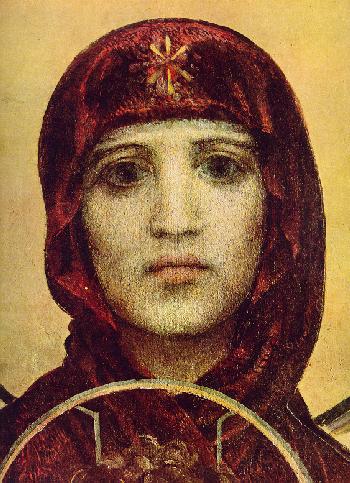
Oil and gold leaf on zinc panel. Museum of Russian Art, Kiev.

 In 1883, when Professor Prakhov visited St. Petersburg Academy, he
asked Vrubel to help with restoration of the twelfth-century Church of
St. Cyril in Kiev. Vrubel was supposed to restore wall paintings and icons.
As it was common at the time, the restoration was nothing else but a complete
repainting of the severely damaged frescoes and icons in the style of the
Russian Revival. Vrubel's monumental depiction of the Virgin Mary and Child
reflects this new style well. On the one hand, the figures of the Virgin
and the Child follow the established Byzantine and Russian tradition: the
Virgin, dressed in a purple-red maphorion, is seated on a throne and holds
the Child in her lap. However, from the point of view of Orthodoxy, the
image created by Vrubel, despite its astonishing beauty, cannot be even
considered an icon. First of all, in place of a typical flat representation,
Vrubel gives his Virgin and Child (unusually large in proportions to the
mother) a pronounced three-dimensional character. This is achieved not
only by the use of oil paints, which, in contrast to the egg tempera, allow
the painter to blend colors and make smooth transitions between light and
darkness, but also by the use of a live model. Following the practice of
the artists of the Italian Renaissance who used their female acquaintances
as models for their Madonnas, Vrubel asked Prakhov's beautiful wife to
pose as the Virgin. Apparently her face, in Vrubel's eyes, was an epitome
of the ideal, spiritual beauty; not only are her eyes large and almond-shaped,
like the eyes of the Virgin on many icons, but they show a similar anxiety
and sadness. The brows are regular, the nose straight but wider than the
traditional thin and long noses on icons, and the slightly puckered lips
seem to be a prelude to tears of a mother who will eventually give up her
son for the sins of the world. Even though strict Orthodoxy would reject
this image for its "earthly" character, from the aesthetic point of view, Vrubel's icon is a powerful and haunting image. [S.H.]
In 1883, when Professor Prakhov visited St. Petersburg Academy, he
asked Vrubel to help with restoration of the twelfth-century Church of
St. Cyril in Kiev. Vrubel was supposed to restore wall paintings and icons.
As it was common at the time, the restoration was nothing else but a complete
repainting of the severely damaged frescoes and icons in the style of the
Russian Revival. Vrubel's monumental depiction of the Virgin Mary and Child
reflects this new style well. On the one hand, the figures of the Virgin
and the Child follow the established Byzantine and Russian tradition: the
Virgin, dressed in a purple-red maphorion, is seated on a throne and holds
the Child in her lap. However, from the point of view of Orthodoxy, the
image created by Vrubel, despite its astonishing beauty, cannot be even
considered an icon. First of all, in place of a typical flat representation,
Vrubel gives his Virgin and Child (unusually large in proportions to the
mother) a pronounced three-dimensional character. This is achieved not
only by the use of oil paints, which, in contrast to the egg tempera, allow
the painter to blend colors and make smooth transitions between light and
darkness, but also by the use of a live model. Following the practice of
the artists of the Italian Renaissance who used their female acquaintances
as models for their Madonnas, Vrubel asked Prakhov's beautiful wife to
pose as the Virgin. Apparently her face, in Vrubel's eyes, was an epitome
of the ideal, spiritual beauty; not only are her eyes large and almond-shaped,
like the eyes of the Virgin on many icons, but they show a similar anxiety
and sadness. The brows are regular, the nose straight but wider than the
traditional thin and long noses on icons, and the slightly puckered lips
seem to be a prelude to tears of a mother who will eventually give up her
son for the sins of the world. Even though strict Orthodoxy would reject
this image for its "earthly" character, from the aesthetic point of view, Vrubel's icon is a powerful and haunting image. [S.H.]
